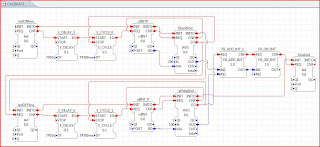For Tutorial 2: Building the Car Wash
Using parts of a LEGO forklift construction to learn how to make something that goes up and down with LEGOs. Mainly learned how to make a track and how far up & down a track works without tilting to 1 side or the other. Next is learning the ultrasound sensor.
Graphical OO SW design mapped to real objects:
Still working on using just 1 light sensor for line follower in 4diac. How to use just 1 light sensor FB mapped to the actual 1 light sensor to read the light sensor to 4 steps:
- calibrate on the line color
- calibrate off the line color
- follow the line
- find line.
then "repeat" for a follow the line application with 3 light sensors.
Want a clean design - currently still looks like spaghetti.
Current direction: Use E_DEMUX to direct the read output to the current step.
Whether it can be implemented similar to the behavior programming design used/described in Lejos documentation - is currently still an open question.
Current direction: Use E_DEMUX to direct the read output to the current step.
Whether it can be implemented similar to the behavior programming design used/described in Lejos documentation - is currently still an open question.
Port mapping, so an application can't say there are 2 sensors on the same sensor port. That should be handled during INITs.
Created an Events palette overview to understand what events are available to use. Everyone starting out seems to ask the same/similar questions.
But what is the basic FB E_LDU (Event-driven Workpiece Load/Unload Model)? It has 2 algorithms, but no ecc?







